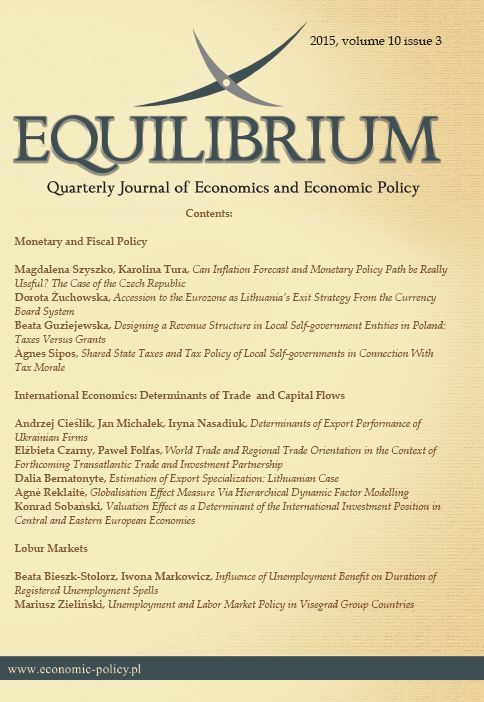Accession to the Eurozone as Lithuania?s exit strategy from the currency board system
DOI:
https://doi.org/10.12775/EQUIL.2015.023Keywords:
currency board, inflation, euro adoption, LithuaniaAbstract
In the years 2004-2014 the Lithuania?s exchange rate policy was based on a rigid currency board system. After a period of uncontested success in the fight against inflation in the first decade of the transition and economic growth, entering the ERM II in 2004 and efforts to adopt the euro were treated as an optimal exit strategy from the currency board system. However, the consequences of this exchange rate system in the following years (until 2014) prevented Lithuania from meeting the economic convergence criteria. The starting point for the research is based on the theoretical analysis of literature studying benefits and risks associated with the use of the currency board system by the monetary authorities. The empirical analysis refers to the case of Lithuania and covers the years 2004-2014. The purpose of this analysis is to look at the effects of the use of the currency board system from the perspective of the convergence criteria of monetary nature and the extent of their implementation in the absence of opportunities for autonomous monetary policy.
Downloads
References
Alonso-Gamo P., Fabrizio S., Kramarenko V., & Wang Q. (2002). Lithuania: History and Future of the Currency Board Arrangement. IMF Working Paper, 02(127).
Bank of Lithuania (1994). Law on the Bank of Lithuania, 12.01.1994, Retrieved form http://www.lb.lt/ (4.06.2009).
Baran K. (2007). Kryterium inflacyjne w rozszerzonej Europie ? podsumowanie dyskusji na temat Litwy. Bank i Kredyt, 6.
Brixiova Z., Morgan M. H., & Wörgötten A. (2010). On The Road to Euro: How Synchronized Is Estonia with the Euro Zone?. European Journal of Comparative Economics, 7(1).
ECB (2004). Convergence Report, European Central Bank, October.
ECB (2006). Convergence Report, European Central Bank, May
ECB (2008). Convergence Report, European Central Bank, May.
ECB (2010). Convergence Report, European Central Bank, May.
ECB (2012). Convergence Report, European Central Bank, May.
ECB (2014). Convergence Report, European Central Bank, June.
Enoch C. & Gulde A-M. (1998). Are Currency Board a Cure for All Monetary Problems?. Finance and Development, 35(4).
Eurostat, Retrieved form http://ec.europa.eu/eurostat/data/database (30.12.2014).
Ghosh A. R. (1998). Currency Boards: The Ultimate Fix?. IMF Working Paper No. 98/8, http://dx.doi.org/10.5089/9781451927955.001.
Gulde A-M., Kähkönen J. & Keller P. (2000). Pros and Cons Currency Board Arrangements in the Lead-up to EU Accession and Participation in the Euro Zone, IMF Policy Discussion Paper, 00(1).
Hanke S. (2002). On dollarization and currency boards: Error and deception. Journal of Policy Reform, 5(4), http://dx.doi.org/10.1080/1384128032 000096814.
Imam P. A. (2010). Exchange Rate Choices of Microstates, IMF Working Paper, 10(12), http://dx.doi.org/10.5089/9781451962000.001.
IMF, World Economic Outlook Database. Retrieved form http://www.imf.org/external/pubs/ft/weo/2014/02/weodata/index.aspx28.12.2014 (28.12.2014).
Jakubiak M. (2000). Design and Operation of Existing Currency Board Arrangements, CASE, Warszawa.
Purfield C. & Rosenberg Ch. B (2010). Adjustment Under a Currency Peg : Estonia, Latvia and Lithuania During the Global Financial Crisis 2008-09, IMF Working Paper, 10(213). http://dx.doi.org/10.5089/9781455205448.001.
Sławiński A. (2001). Argentyna. In: Małecki W., Sławiński A., Piasecki R., Żuławska U., Kryzysy walutowe. Warszawa: PWN.
Sławiński A. (2007). Ryzyko utraty kontroli nad wysokością realnej stopy procentowej w systemie izby walutowej. In B. Polszakiewicz & J. Boehlke (Eds.). Własność i kontrola w teorii i praktyce. Toruń: Wydawnictwo UMK.
Sotomska-Krzysztofik P. (2003). Utworzenie i upadek izby walutowej w Argentynie. Bank i Kredyt, 2.
Torre A., Yeyati E. L., & Schmukler S. L. (2003). Living and Dying with Hard Pegs: The Rise and Fall of Argentina's Currency Board. Policy Research Working Paper, 2980, http://dx.doi.org/10.1596/1813-9450-2980.
Williamson J. (1995). What Role for Currency Boards? Policy Analyses in International Economics. Washington: Institute for International Economics.
Wolf H. C., Ghosh A. R., Berger H., & Gulde A-Marie (2008). Currency Boards in Retrospect and Prospect, Massachusetts Institute of Technology, http://dx.doi.org/10.7551/mitpress/9780262232654.003.0001.
Żuchowska D. (2011). Polityka kursowa a inflacja procesie integracji walutowej Słowenii, Słowacji i Estonii ze strefą euro. Oeconomia Copernicana, 2(1), DOI: http://dx.doi.org/10.12775/OeC.2011.001.






